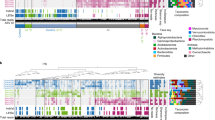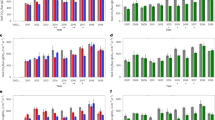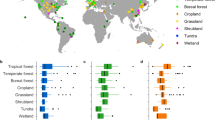Abstract
Tropical soils contain one-third of the carbon stored in soils globally1, so destabilization of soil organic matter caused by the warming predicted for tropical regions this century2 could accelerate climate change by releasing additional carbon dioxide (CO2) to the atmosphere3,4,5,6. Theory predicts that warming should cause only modest carbon loss from tropical soils relative to those at higher latitudes5,7, but there have been no warming experiments in tropical forests to test this8. Here we show that in situ experimental warming of a lowland tropical forest soil on Barro Colorado Island, Panama, caused an unexpectedly large increase in soil CO2 emissions. Two years of warming of the whole soil profile by four degrees Celsius increased CO2 emissions by 55 per cent compared to soils at ambient temperature. The additional CO2 originated from heterotrophic rather than autotrophic sources, and equated to a loss of 8.2 ± 4.2 (one standard error) tonnes of carbon per hectare per year from the breakdown of soil organic matter. During this time, we detected no acclimation of respiration rates, no thermal compensation or change in the temperature sensitivity of enzyme activities, and no change in microbial carbon-use efficiency. These results demonstrate that soil carbon in tropical forests is highly sensitive to warming, creating a potentially substantial positive feedback to climate change.
This is a preview of subscription content, access via your institution
Access options
Access Nature and 54 other Nature Portfolio journals
Get Nature+, our best-value online-access subscription
$29.99 / 30 days
cancel any time
Subscribe to this journal
Receive 51 print issues and online access
$199.00 per year
only $3.90 per issue
Buy this article
- Purchase on Springer Link
- Instant access to full article PDF
Prices may be subject to local taxes which are calculated during checkout



Similar content being viewed by others
Data availability
The source data for this study (soil gas exchange, soil and microbial properties) are available at https://doi.org/10.6084/m9.figshare.12144768. Source data are provided with this paper.
Change history
13 October 2020
A Correction to this paper has been published: https://doi.org/10.1038/s41586-020-2792-9
References
Jackson, R. B. et al. The ecology of soil carbon: pools, vulnerabilities, and biotic and abiotic controls. Annu. Rev. Ecol. Evol. Syst. 48, 419–445 (2017).
Ciais, P. et al. in Climate Change 2013: The Physical Science Basis. Contribution of Working Group I to the Fifth Assessment Report of the Intergovernmental Panel on Climate Change (eds Stocker, T. F. et al.) Ch. 6 (Cambridge Univ. Press, 2013).
Melillo, J. M. et al. Long-term pattern and magnitude of soil carbon feedback to the climate system in a warming world. Science 358, 101–105 (2017).
van Gestel, N. et al. Predicting soil carbon loss with warming. Nature 554, E4–E5 (2018).
Davidson, E. A. & Janssens, I. A. Temperature sensitivity of soil carbon decomposition and feedbacks to climate change. Nature 440, 165–173 (2006).
Hicks Pries, C. E., Castanha, C., Porras, R. C. & Torn, M. S. The whole-soil carbon flux in response to warming. Science 355, 1420–1423 (2017).
Carey, J. C. et al. Temperature response of soil respiration largely unaltered with experimental warming. Proc. Natl Acad. Sci. USA 113, 13797–13802 (2016).
Wood, T. E. et al. in Ecosystem Consequences of Soil Warming: Microbes, Vegetation, Fauna and Soil Biogeochemistry (ed. Mohan, J. E.) Ch. 14, 385–439 (Academic Press, 2019).
Pan, Y. et al. A large and persistent carbon sink in the world’s forests. Science 333, 988–993 (2011).
Anderson-Teixeira, K. J., Wang, M. M. H., McGarvey, J. C. & LeBauer, D. S. Carbon dynamics of mature and regrowth tropical forests derived from a pantropical database (TropForC-db). Glob. Change Biol. 22, 1690–1709 (2016).
Malhi, Y. The productivity, metabolism and carbon cycle of tropical forest vegetation. J. Ecol. 100, 65–75 (2012).
Chambers, J. Q. et al. Respiration from a tropical forest ecosystem: partitioning of sources and low carbon use efficiency. Ecol. Appl. 14, 72–88 (2004).
Romero-Olivares, A. L., Allison, S. D. & Treseder, K. K. Soil microbes and their response to experimental warming over time: a meta-analysis of field studies. Soil Biol. Biochem. 107, 32–40 (2017).
Tang, J. et al. in Ecosystem Consequences of Soil Warming: Microbes, Vegetation, Fauna and Soil Biogeochemistry (ed. Mohan, J. E.) Ch. 8, 175–201 (Academic Press, 2019).
Nottingham, A. T. et al. Climate warming and soil carbon in tropical forests: insights from an elevation gradient in the Peruvian Andes. Bioscience 65, 906–921 (2015).
Todd-Brown, K. E. O. et al. Causes of variation in soil carbon predictions from CMIP5 Earth system models and comparison with observations. Biogeosciences 10, 1717–1736 (2013).
Intergovernmental Panel on Climate Change (IPCC). Global Warming of 1.5 °C: An IPCC Special Report on the Impacts of Global Warming of 1.5 °C Above Pre-Industrial Levels and Related Global Greenhouse Gas Emission Pathways, in the Context of Strengthening the Global Response to the Threat of Climate Change, Sustainable Development, and Efforts to Eradicate Poverty (eds Masson-Delmotte, V. et at.) Ch. 3 (World Meteorological Organization, 2018).
Cox, P. M. et al. Sensitivity of tropical carbon to climate change constrained by carbon dioxide variability. Nature 494, 341–344 (2013).
Mora, C. et al. The projected timing of climate departure from recent variability. Nature 502, 183–187 (2013).
Beaumont, L. J. et al. Impacts of climate change on the world’s most exceptional ecoregions. Proc. Natl Acad. Sci. USA 108, 2306–2311 (2011).
Steidinger, B. S. et al. Climatic controls of decomposition drive the global biogeography of forest-tree symbioses. Nature 569, 404–408 (2019).
Rubio, V. E. & Detto, M. Spatiotemporal variability of soil respiration in a seasonal tropical forest. Ecol. Evol. 7, 7104–7116 (2017).
Frey, S. D., Lee, J., Melillo, J. M. & Six, J. The temperature response of soil microbial efficiency and its feedback to climate. Nat. Clim. Chang. 3, 395–398 (2013).
Bradford, M. A. Thermal adaptation of decomposer communities in warming soils. Front. Microbiol. 4, https://doi.org/10.3389/fmicb.2013.00333 (2013).
Wang, X. H. et al. A two-fold increase of carbon cycle sensitivity to tropical temperature variations. Nature 506, 212–215 (2014).
Liu, J. J. et al. Contrasting carbon cycle responses of the tropical continents to the 2015–2016 El Nino. Science 358, eaam5690 (2017).
Karhu, K. et al. Temperature sensitivity of soil respiration rates enhanced by microbial community response. Nature 513, 81–84 (2014).
Bradford, M. A. et al. Cross-biome patterns in soil microbial respiration predictable from evolutionary theory on thermal adaptation. Nat. Ecol. Evol. 3, 223–231 (2019).
Wieder, R. K. & Wright, S. J. Tropical forest litter dynamics and dry season irrigation on Barro Colorado Island, Panama. Ecology 76, 1971–1979 (1995).
Chave, J. et al. Spatial and temporal variation of biomass in a tropical forest: results from a large census plot in Panama. J. Ecol. 91, 240–252 (2003).
Nottingham, A. T. et al. Microbial responses to warming enhance soil carbon loss following translocation across a tropical forest elevation gradient. Ecol. Lett. 22, 1889–1899 (2019).
Crowther, T. W. et al. Quantifying global soil carbon losses in response to warming. Nature 540, 104–108 (2016).
Leigh, E. G. J. Tropical Forest Ecology: A View from Barro Colorado Island (Oxford Univ. Press, 1999).
Woodring, W. P. Geology of Barro Colorado Island. Smithson. Misc. Collect. 135, 1–39 (1958).
Sanchez, P. A. & Logan, T. J. Myths and science about the chemistry and fertility of soils in the tropics. SSSA Spec. Publ. 29, 35–46 (1992).
Hanson, P. J. et al. A method for experimental heating of intact soil profiles for application to climate change experiments. Glob. Change Biol. 17, 1083–1096 (2011).
Nottingham, A. T., Turner, B. L., Winter, K., van der Heijden, M. G. A. & Tanner, E. V. J. Arbuscular mycorrhizal mycelial respiration in a moist tropical forest. New Phytol. 186, 957–967 (2010).
Cavelier, J. Fine-root biomass and soil properties in a semideciduous and a lower montane rain-forest in Panama. Plant Soil 142, 187–201 (1992).
Sinsabaugh, R. L. et al. Stoichiometry of microbial carbon use efficiency in soils. Ecol. Monogr. 86, 172–189 (2016).
Hendershot, W. H. & Duquette, M. A simple barium-chloride method for determining cation-exchange capacity and exchangeable cations. Soil Sci. Soc. Am. J. 50, 605–608 (1986).
Brookes, P. C., Landman, A., Pruden, G. & Jenkinson, D. S. Chloroform fumigation and the release of soil-nitrogen – a rapid direct extraction method to measure microbial biomass nitrogen in soil. Soil Biol. Biochem. 17, 837–842 (1985).
Vance, E. D., Brookes, P. C. & Jenkinson, D. S. An extraction method for measuring soil microbial biomass-C. Soil Biol. Biochem. 19, 703–707 (1987).
Jenkinson, D. S., Brookes, P. C. & Powlson, D. S. Measuring soil microbial biomass. Soil Biol. Biochem. 36, 5–7 (2004).
Kouno, K., Tuchiya, Y. & Ando, T. Measurement of soil microbial biomass phosphorus by an anion-exchange membrane method. Soil Biol. Biochem. 27, 1353–1357 (1995).
Nottingham, A. T. et al. Soil microbial nutrient constraints along a tropical forest elevation gradient: a belowground test of a biogeochemical paradigm. Biogeosciences 12, 6489–6523 (2015).
Nottingham, A. T. et al. Temperature sensitivity of soil enzymes along an elevation gradient in the Peruvian Andes. Biogeochemistry 127, 217–230 (2016).
Turner, B. L. & Romero, T. E. Short-term changes in extractable inorganic nutrients during storage of tropical rain forest soils. Soil Sci. Soc. Am. J. 73, 1972–1979 (2009).
Zuur, A. F., Ieno, E. N., Walker, N. J., Saveliev, A. A. & Smith, G. M. Mixed Effects Models and Extensions in Ecology with R (Springer, 2007).
Acknowledgements
This study was supported by two fellowships to A.T.N., a European Union Marie-Curie Fellowship FP7-2012-329360 (University of Edinburgh) and a Tupper Fellowship (Smithsonian Tropical Research Institute); a Smithsonian Institution Scholarly Studies Grant to B.L.T. and K. Winter; a UK NERC grant NE/K01627X/1 and an ANU Biology Innovation grant to P.M. We thank O. Acevado, D. Agudo, A. Bielnicka, M. Cano, D. Dominguez, M. Garcia, M. Larsen, B. Martin, M. Montero, S. O’Connor, J. Rodriguez, H. Szczygiel, I. Torres, W. Wcislo, K. Winter and S. J. Wright for their contributions to SWELTR.
Author information
Authors and Affiliations
Contributions
A.T.N. conceived the study with B.L.T. and P.M.; A.T.N., E.V. and B.L.T. performed the study. A.T.N. analysed the data and wrote the paper with B.L.T. and P.M.
Corresponding author
Ethics declarations
Competing interests
The authors declare no competing interests.
Additional information
Peer review information Nature thanks Eric Davidson and the other, anonymous, reviewer(s) for their contribution to the peer review of this work.
Publisher’s note Springer Nature remains neutral with regard to jurisdictional claims in published maps and institutional affiliations.
Extended data figures and tables
Extended Data Fig. 1 Thermal images of a warmed plot.
a–d, Pictures (a, b) and thermal images (c, d) of a warmed plot. The thermal images show the soil-surface temperature 1 h after the warming structure was switched on (c) and after a period of thermal equilibration of soil (d). The circular heating structure was 3.5 m in diameter and extended to 1.2 m depth, which resulted in an effective heated plot of approximately 5 m diameter and 1.2 m depth. The experiment consisted of five warmed and control plot pairs in total. Image credit: J. Bujan and E.V.
Extended Data Fig. 2 Soil moisture content and temperature in control and warmed plots.
a, b, Soil volumetric moisture content (a) and soil temperature (b), for the period after the warming treatment began (December 2016 to December 2018), partitioned by soil depth (columns) and season (rows). Box plots are standard (Tukey) plots, where the centre line represents the median across the five plots over the study period, the lower and upper hinges represent the first and third quartiles, and whiskers represent + 1.5 the interquartile range. c, d, Temporal patterns in soil volumetric moisture content (c) and soil temperature (d), relative to when the warming treatment began (relative day 0; temperature temporarily increased in warmed plots before this during the testing phase). The points are daily means of soil profile and the error bars represent one standard error of the variation by plot (n = 5). The box (Tukey) plots show the median temporal value over sequential 100-day periods. The shaded areas represent dry seasons (1 January to 1 April). Treatment effects on annual or seasonal soil-profile moisture content were not significant; treatment effects on soil temperature were significant (repeated-measures ANOVA, P < 0.001; Extended Data Table 4).
Extended Data Fig. 3 Relationship between soil CO2 efflux, soil moisture and season, in control and warmed plots.
a, b, Relationship between soil CO2 efflux and soil moisture in warmed (red) and control (blue) plots during the dry (a) and wet (b) seasons. Data were fitted (solid lines) using a quadratic function. c, d, Soil CO2 efflux differences between warmed (red) and control (blue) plots during the dry (c) and wet (d) seasons. Soil CO2 efflux in warmed plots was significantly higher than controls for both dry and wet season, although the difference was greater for the wet season (average difference of 2.8 μmol CO2 m−2 s−1 for the wet season compared to 2.1 μmol CO2 m−2 s−1 for the dry season).
Extended Data Fig. 4 Contribution of root-derived and soil-derived sources to total CO2 efflux.
a, b, Data for root-derived (a) and soil-derived (b) sources are for the study period. The error bars for points represent one standard error of the variation across the five plots. The box (Tukey) plots show the median temporal value over 100-day periods. The dotted vertical line is when installation and testing of warming plots began; the dashed vertical line shows when all five warming plots were switched on permanently. The shaded areas represent dry seasons (1 January to 1 April).
Extended Data Fig. 5 Average response of soil properties to warming.
a–c, Data are for the study period December 2016 to December 2018. Data are partitioned into annual (a), dry-season (b) and wet-season (c) responses. Soil properties are microbial CUE (ratio, no units), soil-extractable nutrients (NH4, NO3, resin P; mg kg–1), dissolved organic carbon (DOC; mg kg–1), microbial elements (mic C, mic N, mic P; mg kg–1) and activities (Vmax) of extracellular enzymes β-glucosidase (BG-ase), phosphomonoesterase (P-ase), N-acetyl β-glucosaminidase (N-ase) and β-xylanase (Xy-ase) (nmol MU g–1 min–1). The temperature sensitivity of activities of extracellular enzymes (Q10 of Vmax) was determined for α-glucosidase (AG-ase), BG-ase, P-ase, N-ase, Xy-ase and cellobiohydrolase (Cel-ase) (nmol MU g–1 min–1). Significant responses (P < 0.05) are highlighted in bold and underlined. The only significant annual response (a) is for microbial carbon (P = 0.02), although there is also a marginal non-significant response for β-xylanase activity (P = 0.07). The centre line of each box plot represents the median across the five plots over the study period, the lower and upper hinges represent the first and third quartiles, and whiskers represent + 1.5 the interquartile range.
Rights and permissions
About this article
Cite this article
Nottingham, A.T., Meir, P., Velasquez, E. et al. Soil carbon loss by experimental warming in a tropical forest. Nature 584, 234–237 (2020). https://doi.org/10.1038/s41586-020-2566-4
Received:
Accepted:
Published:
Issue Date:
DOI: https://doi.org/10.1038/s41586-020-2566-4
This article is cited by
-
Emergent temperature sensitivity of soil organic carbon driven by mineral associations
Nature Geoscience (2024)
-
Projected soil carbon loss with warming in constrained Earth system models
Nature Communications (2024)
-
Respiratory Acclimation of Tropical Forest Roots in Response to In Situ Experimental Warming and Hurricane Disturbance
Ecosystems (2024)
-
Warming and flooding have different effects on organic carbon stability in mangrove soils
Journal of Soils and Sediments (2024)
-
Rhizosphere influence on microbial functions: consequence for temperature sensitivity of soil organic matter decomposition at early stage of plant growth
Plant and Soil (2024)
Comments
By submitting a comment you agree to abide by our Terms and Community Guidelines. If you find something abusive or that does not comply with our terms or guidelines please flag it as inappropriate.



